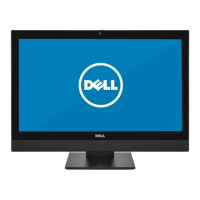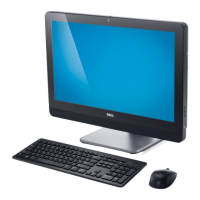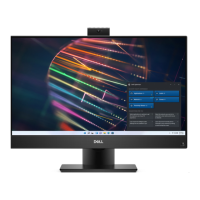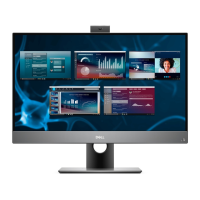Chassis enclosure and ventilation requirements
Enclosure ventilation
If your enclosure has doors, they need to be of a type that allows at least 30% airflow through the enclosure (front and back).
Enclosure minimum clearance
Leave a 10.20 cm (4 in.) minimum clearance on all vented sides of the computer to permit the airflow required for proper
ventilation.
Recommended enclosure
Do not install your computer in an enclosure that does not allow airflow/dusty environment/temperate over 35ºC. Do not put
any objects to directly block air-vent. This restricts the airflow and impacts your computer’s performance, possibly causing it to
overheat.
Open desk minimum clearance
If your computer is installed in a corner, on a desk, or under a desk, leave at least 5.10 cm (2 in.) clearance from the back of the
computer to the wall to permit the airflow required for proper ventilation.
System management features
Dell commercial systems come with a number of systems management options that are include by default for In-Band
management with our Dell Client Command Suite. In-Band management meaning that the Operating System is functional and
the device is connected to a network so that it can be managed. The Dell Client Command Suite of tools can be leveraged
individually or with a systems management console like SCCM, LANDESK, KACE, etc.
We also offer Out-of-Band management as an option. Out-of-band management is when the system does not have a functional
operating system or is turned off and you still want to be able to manage the system in that state.
Dell Client Command Suite for In-Band systems management
Dell Client Command Suite is a free toolkit available for download, for all Latitude Rugged tablets at dell.com/support, that
automates and streamlines systems management tasks, saving time, money, and resources. It consists of the following modules
that can be used independently, or with a variety of systems management consoles such as SCCM.
Dell Client Command Suite's integration with VMware Workspace ONE Powered by AirWatch, now allows customers to manage
their Dell client hardware from the cloud, using a single Workspace ONE console.
Dell Command | Deploy enables easy operating system (OS) deployment across all major OS deployment methodologies and
provides numerous system-specific drivers that have been extracted and reduced to an OS-consumable state.
Dell Command l Configure is a graphical user interface (GUI) admin tool for configuring and deploying hardware settings in a
pre-OS or post-OS environment, and it operates seamlessly with SCCM and Airwatch and can be self-integrated into LANDesk
and KACE. Simply, this is all about the BIOS. Command l Configure allows you to remotely automate and configure over 150+
BIOS settings for a personalized user experience.
Dell Command l PowerShell Provider can do the same things as Command l Configure, but with a different method.
PowerShell is a scripting language that allows customers to create a customized and dynamic configuration process.
Dell Command l Monitor is a Windows Management Instrumentation (WMI) agent that provides IT admins with an extensive
inventory of the hardware and health-state data. Admins can also configure hardware remotely by using command line and
scripting.
Dell Command l Power Manager (end-user tool) is a GUI-based factory-installed battery management tool that allows end
users to choose the battery management methods that meet their personal preferences or work schedule without sacrificing
IT's capability to control those settings with Group Policy.
Dell Command | Update (end-user tool) is factory-installed and allows admins to individually manage and automatically
present and install Dell updates to the BIOS, drivers, and software. Command l Update eliminates the time-consuming hunting
and pecking process of update installation.
Dell Command l Update Catalog provides searchable metadata that allows the management console to retrieve the latest
system-specific updates (driver, firmware or BIOS). The updates are then delivered seamlessly to end-users using the
customer's systems management infrastructure that is consuming the catalog (like SCCM).
46
Engineering specifications

